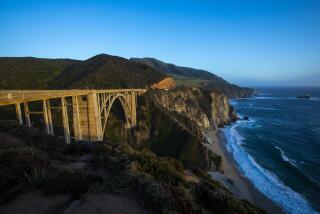New Deal to Protect Hearst Ranch Considered
- Share via
The Hearst Corp. is considering a $100-million conservation deal that would forsake previous development plans for its historic family ranch and deed virtually all of its oceanfront acreage -- the ranchland west of California Highway 1 -- to the state, sources said Tuesday.
At the same time, the family would like to hold on to a few private beaches along its 18 miles of spectacular coastline and retain the option to build homes on 27 different lots for future Hearst generations, sources said.
“There will be no residential or commercial construction west of Highway 1,” said Stephen T. Hearst, vice president and general manager of the Hearst Corp.’s land and livestock division.
The only exception, he said, would be possible construction of a small inn within the already developed borders of Old San Simeon Village next to San Simeon Point.
The plan for the ranch remains a work in progress, with the details beginning to emerge as the Hearst Corp. abruptly broke off negotiations with two groups, the Nature Conservancy and the Conservation Fund, and launched into a new round of talks with the San Francisco-based American Land Conservancy.
The idea is that the “conservation partner,” as Hearst calls it, would help raise public and private money to compensate the corporation for setting aside the picturesque property from development. The 128-square-mile ranch surrounds Hearst Castle in northern San Luis Obispo County.
Hearst is one of a growing list of major property owners, including the owners of Ballona Wetlands in Los Angeles, Bolsa Chica in Huntington Beach and Cargill salt flats in South San Francisco Bay, trying to tap into the hundreds of millions of dollars available for conservation projects through voter-passed state bonds.
Hearst decided last year to sell its development rights instead of reviving dormant plans to build a 650-room hotel complex, golf course and dude ranch -- a proposal that provoked broad public opposition and was rebuffed by the state Coastal Commission four years ago.
Graham Chisholm, executive director of the Nature Conservancy of California, said he was disappointed that Hearst broke off negotiations after 14 months. But he said he hoped that Hearst Ranch gets the protection it deserves and Californians get their money’s worth.
“Californians have been very generous in passing bond measures,” he said. “In order to continue that, Californians deserve to receive good terms. It’s very important that we look carefully at the value of the property and the benefits the public receives.”
Surprisingly, negotiators on both sides deny that money caused the talks to break down. Neither side would publicly discuss monetary issues, but sources said the figure ranges from a little under $100 million to as much as $150 million.
The sticking points were focused more on what the public would get for its money. “The way things were going, they were going to sell us most or all of the land west of the highway and an easement on the land east of Highway 1,” said Sam Schuchet, executive director of the Coastal Conservancy, a state agency that awards bond money.
Schuchet said he found the coastal acquisition intriguing, in part because it would add 18 miles to the California Coastal Trail, an ambitious project to complete a continuous foot path along the state’s entire 1,150-mile coastline.
But reserving some beaches as private enclaves for the Hearsts, he said, would be problematic for his agency, which is charged with expanding public beach access. He also was concerned about how the Hearsts might build on the 27 lots. Specifically, the concerns are whether these homes would be set back from the coast, out of public view and clustered together so they do not fragment habitat for wildlife.
Stephen Hearst declined to discuss many details of the negotiations, including the topic of private beaches. “All of these issues will be worked out, but public access will be increased” along the beachfront, Hearst said. As of now, he pointed out, all 18 miles of the coastline remain private property -- although the ranching family has allowed windsurfers to use the beach as well as tourists who stop to watch growing colonies of elephant seals.
Kara Blakeslee, an employee of the Nature Conservancy working on the Hearst deal, resigned this week to join the American Land Conservancy solely to complete the deal. She said she is “extremely optimistic” that an agreement will be reached within months, if not weeks.
“This is the most exciting project I’ve ever had a chance to work with,” she said. “If we didn’t protect Yosemite Valley when we did, it would be gone now. Some people think this is better than Yosemite Valley.”
More to Read
Sign up for Essential California
The most important California stories and recommendations in your inbox every morning.
You may occasionally receive promotional content from the Los Angeles Times.









